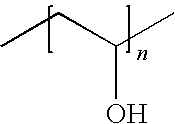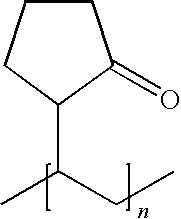Multipurpose hydrogel compositions and products
a technology of multi-purpose hydrogels and compositions, applied in drug compositions, bandages, therapy, etc., can solve the problems of unreacted initiators of chemical reactions, byproducts of chemical reactions, and byproducts of chemical reactions, and achieve high mechanical strength, wide application range, and low strength
- Summary
- Abstract
- Description
- Claims
- Application Information
AI Technical Summary
Benefits of technology
Problems solved by technology
Method used
Image
Examples
example 1
[0077]3% w / v PVA (molecular weight 125 kDa; degree of hydrolysis 88%) is dissolved with stirring in de-ionized, hot water. The solution is cooled to room temperature. 4% w / v PVP (molecular weight 360 kDa; K90), 1.75% w / v κ-carrageenan, 0.05% w / v methyl paraben, and 0.03% w / v propyl paraben are added to the solution and the solution is stirred until all components are dissolved. The solution is allowed to stand over night at room temperature. The solution is heated to about 90° C. and the temperature is maintained for 5 to 10 minutes.
[0078]The hot solution is cooled to about 60° C. and poured into a mold. If a backing material is desired, a backing material, such as a woven or non-woven fabric, a net, or a mesh made of synthetic or natural (e.g., cotton) material, is placed within the mold prior to introduction of the hot solution. The solution and mold are further cooled to about 15° C. to set the thermoreversible gel.
[0079]The thermoreversible gel is then removed from the mold and ...
example 2
[0081]3% w / v PVA (molecular weight 125 kDa; degree of hydrolysis 88%) is dissolved with stirring in de-ionized, hot water. The solution is cooled to room temperature. 4% w / v PVP (K-90; molecular weight 360 kDa), 2.5% w / v κ-carrageenan, 0.05% w / v methyl paraben, 0.03% w / v propyl paraben, and 1% w / v carbomer, acryl amide, or polyacrylic acid are added to the solution and the solution is stirred until all components are dissolved. The solution is allowed to stand over night at room temperature. The solution is heated to about 90° C. and the temperature is maintained for 5 to 10 minutes.
[0082]The hot solution is cooled to about 60° C. and poured into a mold. If a backing material is desired, a backing material, such as a woven or non-woven fabric, a net, or a mesh made of synthetic or natural (e.g., cotton) material, is placed within the mold prior to introduction of the hot solution. The solution and mold are further cooled to about 15° C. to set the thermoreversible gel.
[0083]The ther...
example 3
[0085]3% w / v PVA (molecular weight 125 kDa; degree of hydrolysis 88%) is dissolved with stirring in de-ionized, hot water. The solution is cooled to room temperature. 4% w / v PVP (K-90; molecular weight 360 kDa), 1.5% w / v κ-carrageenan, 0.05% w / v methyl paraben, 0.03% w / v propyl paraben, and 1% w / v carbomer, acryl amide or polyacrylic acid are added to the solution and the solution is stirred until all components are dissolved. The solution is allowed to stand over night at room temperature. The solution is heated to about 90° C. and the temperature is maintained for 5 to 10 minutes.
[0086]The hot solution is cooled to about 60° C. and poured into a mold. If a backing material is desired, a backing material, such as a woven or non-woven fabric, a net, or a mesh made of synthetic or natural (e.g., cotton) material, is placed within the mold prior to introduction of the hot solution. The solution and mold are further cooled to about 15° C. to set the thermoreversible gel.
[0087]The therm...
PUM
| Property | Measurement | Unit |
|---|---|---|
| molecular weight | aaaaa | aaaaa |
| molecular weight | aaaaa | aaaaa |
| molecular weight | aaaaa | aaaaa |
Abstract
Description
Claims
Application Information
 Login to View More
Login to View More - R&D
- Intellectual Property
- Life Sciences
- Materials
- Tech Scout
- Unparalleled Data Quality
- Higher Quality Content
- 60% Fewer Hallucinations
Browse by: Latest US Patents, China's latest patents, Technical Efficacy Thesaurus, Application Domain, Technology Topic, Popular Technical Reports.
© 2025 PatSnap. All rights reserved.Legal|Privacy policy|Modern Slavery Act Transparency Statement|Sitemap|About US| Contact US: help@patsnap.com


